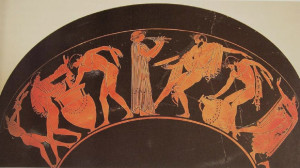This project pursued various research approaches to investigate the use and formation of metaphors in the cultural and religious realm of the Greek symposion, mainly in the archaic and classical periods.
Research

Vessel, showing scenes of dance and music; attic red-figured drinking bowl, around 410 BC | Source: Antikensammlung Berlin| Photo: Johannes Laurentius / SMPK
Two different perspectives of research have been chosen. Firstly, the analysis of spatial metaphors connecting the symposion’s inner space with exterior spaces (the symposion as garden, sanctuary in the open air, ship), but also the focus on metaphorization of the symposion space itself, attributing specific qualities to it, for instance religious ones (the symposion as analogy of a blessed afterlife), or philosophical ones (the symposion as model of communicative cognition processes).
Secondly, the pursuit of the following question: in which way did the (imagined or real) context of the symposion contribute to the formation of particular poetical and philosophical metaphors that transform sensual experiences into concepts of knowledge or to amalgamate both?
Results
Both perspectives have been approached by investigating the metaphorical function of the mixing vessel (kratēr), an indispensable physical object in the space of the symposion and for its practices, in ancient Greek literature. This investigation, which was first presented by the principal investigator, Renate Schlesier, in a workshop on spatial metaphors of the Topoi research group (C-2) Space and Metaphor in 2014, was published as an article in the conference volume based on this workshop:
Renate Schlesier, “KRATĒR. The Mixing-Vessel as Metaphorical Space in Ancient Greek Tradition”, in: Fabian Horn and Cilliers Breytenbach (Eds.), Spatial Metaphors. Ancient Texts and Transformations, Berlin: Edition Topoi, 2016, 69–84
While this article analysed different types of transfer – metaphorical and non-metaphorical ones – connected with the mixing vessel in ancient literary texts (Homer, archaic and Hellenistic lyric), other articles of Renate Schlesier (www.topoi.org/person/schlesier-renate/publications/) have focused on the function of metaphors of the sympotic space in general and on other vessels used at the symposion with special regard to archaic lyric and its ancient reception.
The results of these analyses have been presented as talks at international conferences or as individual lectures: at the universities of Oxford and Reading (UK), Warsaw and Krakow (Poland), Basel and Zurich (Switzerland), Berkeley and Harvard (USA), Liège (Belgium), Munich and Göttingen (Germany). At these occasions, existing networks between the principal investigator and other scholars could be reinforced, e.g. with departments of Classics in the United Kingdom, Poland, Switzerland, and the USA. Furthermore, collaboration with international research groups on ancient Greek religion as well on ancient lyric poetry could be strengthened, and plans made for future co-operative projects (including not only lectures, conferences, and publications, but also guest fellowships).
Further research and results
From June 2015 to April 2016, Sebastian Zerhoch was a postdoctoral fellow in Topoi. In his project, ‘Libation as a Spatial Metaphor in Classical Greek Literature’, he explored a topic that can be considered as exemplary for the issues pursued in the research project (C-2-4). Libation, i.e. the ritual pouring of liquid, is integral to the Greek symposion, and, when used as a metaphor, it often refers to the experience and space of this institution. He analysed libation as a metaphor against the background of the characteristic features of the libation ritual. His aim was to show the thematic range of libation as a literary motif, and, in particular, to identify which specific actions and concepts were metaphorically described as libation.
Sebastian Zerhoch presented his project in the Topoi workshop ‘Metaphors We Choose By’, organized by members of the research group (C-2) Space and Metaphor.
